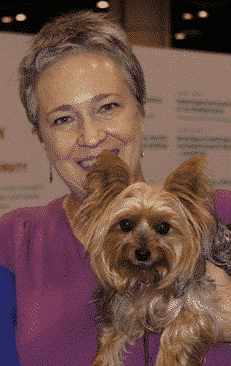
Home » The Rottweiler Gestalt
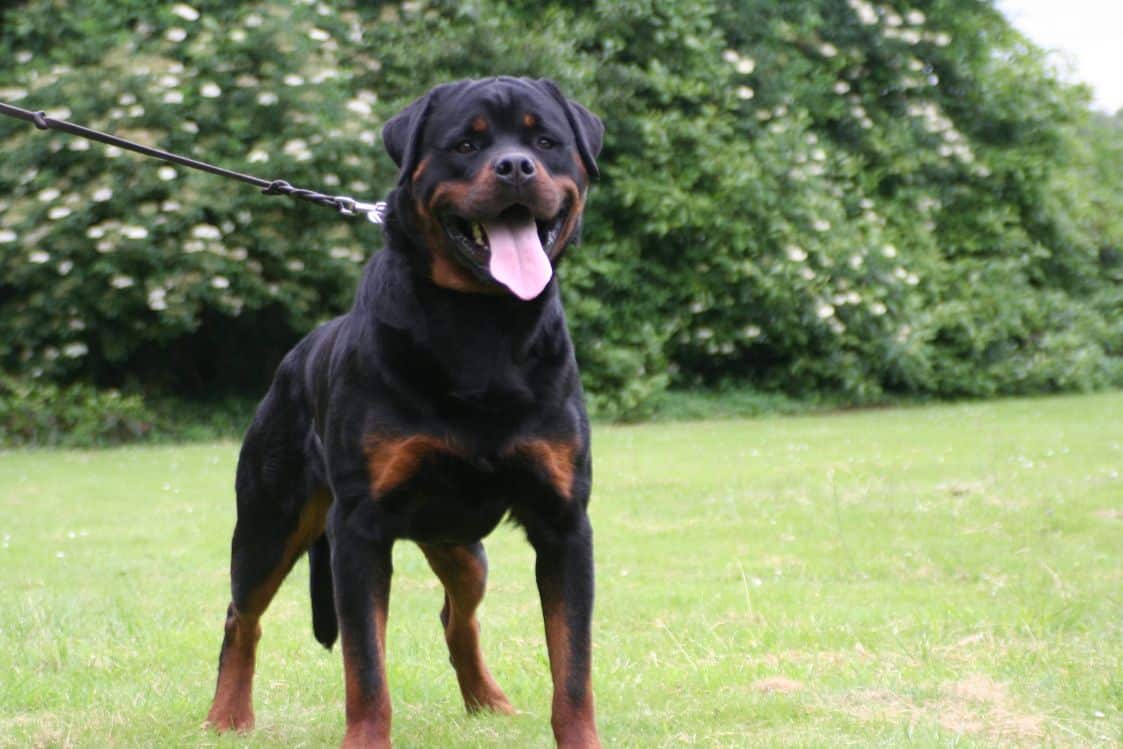
Most articles written about a breed go over the same “big picture” points you hear over and over again… balance, pleasing, proportion. It’s unlikely anyone reading this article—in a show dog-centric magazine with a dedicated section on the Rottweiler—needs to hear about the “big points” again. Principles such as a 9-to-10 ratio are known. A well-angulated front and rear, scissors bite, and almond eye are a given. Easy. Learned it. Got it.
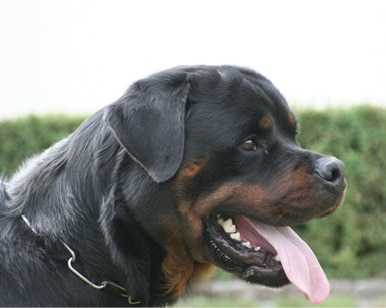
But being faithful to small attributes is more difficult; difficult to remember if you judge multiple breeds (for example, a light eye in a hunting dog may be normal, but it is unacceptable in the Rottweiler), and difficult to pay attention to those seemingly “cosmetic” aspects that are truly important to breeders and to breeding programs. So, rather than once again talk about the usual over-arching points, this article will expound upon the small, perhaps even dull, features that, when put together, truly add up to a superior specimen of the Rottweiler. (Adherence to small details won’t be bad for your judging reputation either.)
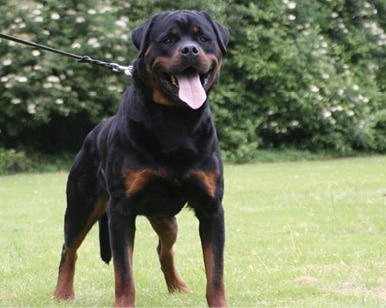
To begin with, remember this one word: Dark. Dark brown, almond-shaped eyes; dark black mouth, including gums and lips; dark mahogany markings (not straw or tan); dark body, not overtaken by excessively large or light-colored markings. (If the markings on the front legs go up and reach the underside, and connect with the chest markings and reach across the undercarriage, touching the markings on the rear legs to form one large blot, the markings are too large. They are markings—separate markings on the legs, cheeks, muzzle, chest, and buttocks.) We are a dark and stealthy breed—not bright and noticeable. Having said that, markings are to be defined; markings that are missing, difficult to discern or overly muddy are to be faulted.

Speaking of mouths, if the best dog you can find has missing teeth or malocclusion, look again. While our standard allows for one missing tooth, it is a serious fault. There was a time when missing teeth were more of the norm, but a lot of work has been done in favor of full dentition. Watch for wry bites too. A scissors bite with full dentition in a dark mouth, both lips and gums, is desired. (If you really want to see people sweat, ask the handler of a dog you like to lift the lips to look at gum color!)

The Rottweiler should not exude elegance or refinement. We are a rough and ready, working farm dog, cattle drover, predator aware, stranger questioning, child-loving, handler compliant, cart pulling, no-nonsense type of dog. We are called the “Noble Breed” for a reason—the Rottweiler doesn’t have to make a show of being present because he is better, smarter, and stronger than the others around him. The Rottweiler is dignified, circumspect, and keeps close council. While Rottweilers are known for silliness and pranks with their families, they are never—never—to come across as stupid. Quiet confidence is the preferred mode. They should always appear as if they are thinking—because they are.

If an entry is making a big show with barking, lunging, spinning, or outward belligerence, please excuse it. The Rottweiler is not to display behaviors that speak of insecurity, being stimulated over its threshold or outright aggression towards humans (even if it’s displaced). The Rottweiler is attentive to his handler and obedient to direction, unless threatened.

Difficulty in discerning correctness presents itself when the Rottweiler moves. There are two common errors; 1.) being taken in by flashy movement or, 2.) a dog that is too long and elegant. “Flashy” movement refers to movement that is eye-catching and heart-quickening. These are usually dogs that are straight in their front and rear angulation, causing the front legs to reach up rather than out from the shoulder, and the rear legs to cycle quickly underneath. This gives a lot of motion and it looks exciting—but it doesn’t cover ground efficiently, all the while burning a lot of energy while going nowhere. It’s understandable how thrilling it is to watch; after all, it’s a dog show, and it is showy! Crowds may love it, but it is, unfortunately, incorrect.

There is no argument that smooth, elegant movement is awe-inspiring. Watching a beautiful Afghan or Setter go around the ring can cause you to catch your breath. Elegant movement usually equates to a longer back, and the Rottweiler standard specifically calls for a short, strong back. When presented with a graceful-moving dog, check yourself. Is everything else there as well? Is the back short? Are the body proportions correct and is the dog almost square? Are the rear feet reaching to the midline of the back, but not crossing over or to the side? Is the rear angulation harmonious with the front? Ground-covering, efficient movement (correct) can easily be confused with elegant movement (incorrect).
When you do see a dog that is straight in the front, you might also have a dog lacking in chest depth and width. Without shoulder layback, the dog is often narrow and shallow. This is a dog that will tire quickly, both from burning more energy to cover ground and from insufficient room for the heart and lungs. Speaking of narrow, our breed must have bone strength. Without it, the Rottweiler becomes weak-looking and spindly. We are strong, thick, and grounded. Weedy, spindly dogs are not to be awarded.
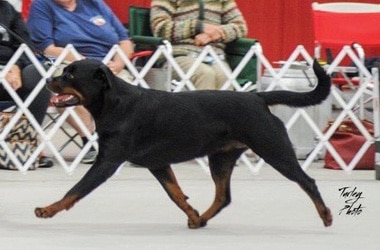
The Rottweiler is moderate in head type. We are not short-muzzled like Bullmastiffs or Boxers. The Rottweiler must be able to breathe freely, without labor. The head is smooth all around, without excessive wrinkling, dewlaps, or open flews. Too large an ear or too high or low an ear set can make a Rottweiler look houndy, and frankly, clownish. (See photo left—demeanor and appearance is “Noble.”)

Now a brief mention of an issue that really is no longer much of an issue for most people—tails. Please don’t be afraid of tails on a Rottweiler—they are born with them. Contrary to the belief of many, the cropping and docking ban in Europe was not instigated by “animal rights” people. It was decided by the World Veterinary Organization, based on the science of pain, doing no harm to animals, and only performing surgical intervention (yes, tail docking is a surgical procedure) when medically necessary. The American Veterinary Medical Association stands in agreement with the WVO. For more information, see https://www.avma.org/resources-tools/literature-reviews/welfare-implications-tail-docking-dogs or https://www.academia.edu/38043016/Tail_Docking_in_Dogs_Historical_Precedence_and_Modern_Views.
By recognizing and awarding the best of our breed, you are part of our dedication to excellence.
Our standard may say “docked short,” but it does not state “must be docked.” It also states the set of the tail is more important than the length, which gives judges the option to put up the best dog, not the best docked dog. In 2017, 17% of all class entries at the American Rottweiler Club National were natural tailed. If you are presented with a tailed entry, ignore the tail and look at the overall dog—proportion, angulation, movement, muscling, condition, temperament, color and pigment.
The Rottweiler has come a long way over the decades, with many admirable changes for the better. Help us keep the Rottweiler a working dog, one that loves to wake up every day to new tasks and challenges, always present with good nature and enthusiasm. By recognizing and awarding the best of our breed, you are part of our dedication to excellence.
